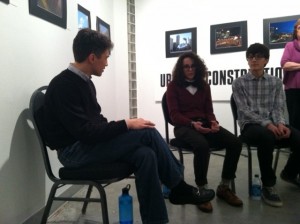
Photographers Dani and Devin speak with the Alliance Theatre's Director of Educational Programs, Christopher Moses.
“Urban Deconstruction,” an exhibit sponsored by Wells Fargo’s ArtsVibe Teen Program and the Juvenile Justice Information Exchange (JJIE), paints a dual portrait of Atlanta as both a modern marvel and a city in decay. The photographs on display at the Alliance Theater are a vision of the Southeastern metropolis as both towering buildings and dilapidated structures, a place where spiraling skyscrapers stand side-by-side with crumbling schoolhouses and abandoned, graffiti-covered interiors. The artwork, much like the city itself, is a demonstration of sharp contrasts and contradictions.
The artists behind the exhibit, however, aren’t your average photojournalists. Devin Black, 18, of Sandy Springs, Ga. and Dani Planer, 15, of Atlanta, are two photographers who have been given a spotlight that would make most postgraduate photographers envious.
“It’s definitely really cool,” Black said about having his photographs on display at one of the Southeast’s most prestigious galleries. “Having it up on the wall is a lot better than just showing people your photos on a laptop screen.”
Planer also considers herself both honored and privileged to have her photographs on display. “I wasn’t expecting anything like this to come out of it,” she said.
Black and Planer’s project began when the two took a journalism class together at Atlanta’s The Galloway School, and became aware of their mutual photography interests. “We both like living in the city and exploring it,” Black said.
Planer said what would eventually become “Urban Deconstruction” began when, one day, they simply went outdoors and started taking photographs of their local landscape.
“When we walked outside the city,” Planer said, “we saw what it truly consisted of, which was deconstructed buildings and just an abandoned Atlanta, basically.”
She recalls entering an abandoned building off Dekalb Avenue and being surprised by the amount of overgrowth encircling it. “One of the buildings was just so overgrown with trees and vines that it was almost like it wasn’t even in the city anymore,” she said. The site of her favorite photograph in the exhibit, she stated, more closely resembled forest scenery than a metropolitan area.
Black believes the photographs give people a view of the city that some individuals living in Atlanta may never encounter. “Looking back,” he said, “they kind of give people a window on Atlanta.”
Black said his favorite photograph in the exhibition harked back to a peculiar childhood interest.
“I know one photo I kind of cherish,” he said. “It’s the photo of all the traffic safety lights, just scattered on a big pile on the floor.”
“As a kid,” he continued, “for some reason, I was obsessed with traffic cones and roadwork equipment.”
Black, who has applied to schools such as New York University, Northeastern University and the University of California, Los Angeles, said he would like explore some “creative ventures” for his next project. He said he wishes to continue photographing Atlanta’s urban landscapes, particularly finding ways to incorporate the city’s inhabitants into his artwork. “It adds a lot more to the story of a picture,” he said.
Planer said she wants patrons of the exhibit to note the duality of their metropolitan stomping grounds.
“We hope people realize that the beautiful city that they live in also consists of these abandoned buildings that they see every day, but don’t even notice,” she said.
After high school, Planer said she would like to minor in photography while pursuing a major in psychology, stating that she would like to one day do another photographic project about families. “Photographs of different families, from different cultures,” she said. “With, I guess, 10 items that represent what their kind of culture is.”
Leonard Witt, executive director of the Center for Sustainable Journalism, praised Black and Planer’s photography, stating that he felt “honored” to publish their work on JJIE prior to the Woodruff Arts Center exhibit.
“We feel honored that they chose us first and more importantly that they might lead the way for other youth produced special projects,” Witt said. “After all, our mission is to provide insight into issues affecting youth and who better to provide that insight than youth themselves.”
“Urban Deconstruction” will be on display at the Joseph R. Bankoff Gallery at the Woodruff Arts Center until Jan 21.
Photo by John Flemming.
